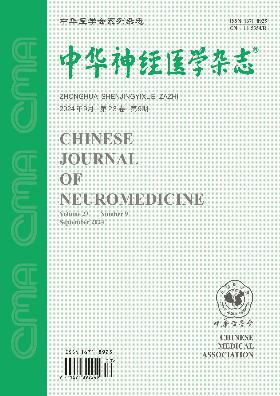Effect of tail vein transplantation of human amniotic mesenchymal stem cells with different transforming growth factor-β expressions on sciatic nerve function in xenografted mice
Q4 Medicine
引用次数: 0
Abstract
Objective To investigate the effect of tail vein transplantation of human amniotic mesenchymal stem cells (hAMSCs) with different transforming growth factor (TGF)-β expressions on recovery of sciatic nerve function in peripheral nerve xenotransplantation mice. Methods The hAMSCs were isolated from amnion membranes by healthy mother donors and identified by fluorescence activated cell sorter. The up-regulated and down-regulated TGF-β lentiviral plasmids were constructed and transfected into the purified hAMSCs; hAMSCs with stable up-regulated or down-regulated TGF-β expression were constructed. The sciatic nerves of C57BL/6 mice were isolated and cut out, and sciatic nerves of SD rats were isolated and transplanted into the sciatic nerve defected C57BL/6 mice to construct peripheral nerve xeno-transplanted mice models; these mice models were divided into 4 groups (n=10) according to random number table: control group, hAMSCs treatment group, high-expressed TGF-β hAMSCs treatment group, and low-expressed TGF-β hAMSCs treatment group; one d before modeling, phosphate buffer saline (PBS) or hAMSCs re-suspension were drawn with a syringe and slowly pushed into the tail veins of mice for transplantation treatment; 14 d after treatment, DigGait analysis system was used to evaluate the recovery of sciatic nerve function in each group of mice. Result Fourteen d after treatment, the sciatic nerve function index (SFI) of the high-expressed TGF-β hAMSCs treatment group (-25.820±0.286) was significantly higher than that of the low-expressed TGF-β hAMSCs treatment group (-33.413±0.920) and hAMSCs treatment group (-30.755±0.421, P<0.05). Conclusion The tail vein transplantation of hAMSCs with TGF-β high expression can effectively improve the sciatic nerve function in peripheral nerve xenotransplantation mice, which may be a new breakthrough in the treatment of peripheral nerve defects. Key words: Human amniotic mesenchymal stem cell; Transforming growth factor-β; Stem cell therapy; Peripheral nerve defect不同转化生长因子-β表达的人羊膜间充质干细胞尾静脉移植对移植小鼠坐骨神经功能的影响
目的探讨不同转化生长因子(TGF)-β表达的人羊膜间充质干细胞(hAMSCs)尾静脉移植对周围神经异种移植小鼠坐骨神经功能恢复的影响。方法从健康供体羊膜中分离hAMSCs,采用荧光活化细胞分选仪进行鉴定。构建上调和下调的TGF-β慢病毒质粒,转染纯化的hAMSCs;构建TGF-β表达稳定上调或下调的hAMSCs。分离并切除C57BL/6小鼠坐骨神经,分离SD大鼠坐骨神经,移植到坐骨神经缺损的C57BL/6小鼠体内,构建外周神经移植小鼠模型;将小鼠模型按随机数字表法分为4组(n=10):对照组、hAMSCs治疗组、高表达TGF-β hAMSCs治疗组、低表达TGF-β hAMSCs治疗组;造模前1 d,用注射器抽取磷酸盐缓冲盐水(PBS)或hAMSCs重悬液,缓慢推入小鼠尾静脉进行移植治疗;治疗14 d后,采用dig步态分析系统评价各组小鼠坐骨神经功能恢复情况。结果治疗14 d后,高表达TGF-β hAMSCs治疗组坐骨神经功能指数(SFI)(-25.820±0.286)显著高于低表达TGF-β hAMSCs治疗组(-33.413±0.920)和hAMSCs治疗组(-30.755±0.421,P<0.05)。结论TGF-β高表达的hAMSCs尾静脉移植能有效改善周围神经异种移植小鼠坐骨神经功能,可能是周围神经缺损治疗的新突破。关键词:人羊膜间充质干细胞;转化生长因子-β;干细胞治疗;周围神经缺损
本文章由计算机程序翻译,如有差异,请以英文原文为准。
求助全文
约1分钟内获得全文
求助全文
来源期刊

中华神经医学杂志
Psychology-Neuropsychology and Physiological Psychology
CiteScore
0.30
自引率
0.00%
发文量
6272
期刊介绍:
 求助内容:
求助内容: 应助结果提醒方式:
应助结果提醒方式:


